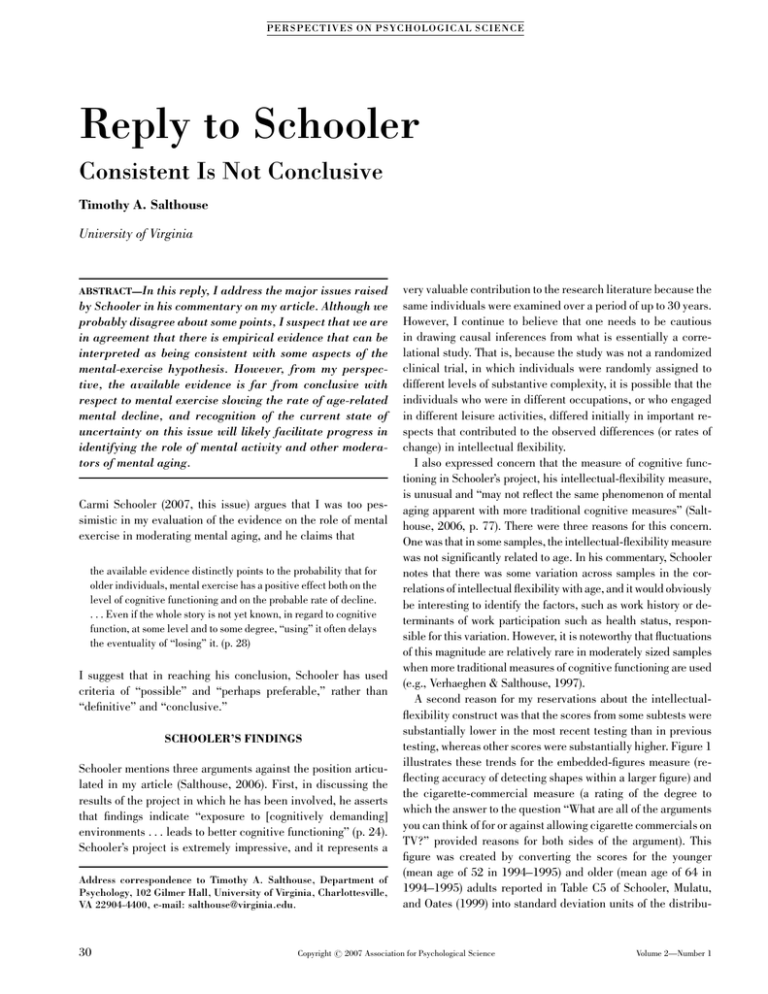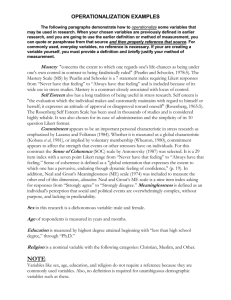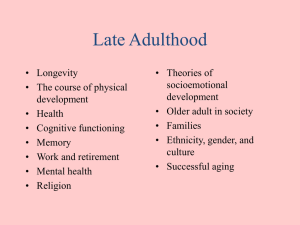Reply to Schooler Consistent Is Not Conclusive Timothy A. Salthouse University of Virginia
advertisement

PE R SP EC TI V ES O N P SY CH O L O G I CA L S CIE N CE Reply to Schooler Consistent Is Not Conclusive Timothy A. Salthouse University of Virginia ABSTRACT—In this reply, I address the major issues raised by Schooler in his commentary on my article. Although we probably disagree about some points, I suspect that we are in agreement that there is empirical evidence that can be interpreted as being consistent with some aspects of the mental-exercise hypothesis. However, from my perspective, the available evidence is far from conclusive with respect to mental exercise slowing the rate of age-related mental decline, and recognition of the current state of uncertainty on this issue will likely facilitate progress in identifying the role of mental activity and other moderators of mental aging. Carmi Schooler (2007, this issue) argues that I was too pessimistic in my evaluation of the evidence on the role of mental exercise in moderating mental aging, and he claims that the available evidence distinctly points to the probability that for older individuals, mental exercise has a positive effect both on the level of cognitive functioning and on the probable rate of decline. . . . Even if the whole story is not yet known, in regard to cognitive function, at some level and to some degree, ‘‘using’’ it often delays the eventuality of ‘‘losing’’ it. (p. 28) I suggest that in reaching his conclusion, Schooler has used criteria of ‘‘possible’’ and ‘‘perhaps preferable,’’ rather than ‘‘definitive’’ and ‘‘conclusive.’’ SCHOOLER’S FINDINGS Schooler mentions three arguments against the position articulated in my article (Salthouse, 2006). First, in discussing the results of the project in which he has been involved, he asserts that findings indicate ‘‘exposure to [cognitively demanding] environments . . . leads to better cognitive functioning’’ (p. 24). Schooler’s project is extremely impressive, and it represents a Address correspondence to Timothy A. Salthouse, Department of Psychology, 102 Gilmer Hall, University of Virginia, Charlottesville, VA 22904-4400, e-mail: salthouse@virginia.edu. 30 very valuable contribution to the research literature because the same individuals were examined over a period of up to 30 years. However, I continue to believe that one needs to be cautious in drawing causal inferences from what is essentially a correlational study. That is, because the study was not a randomized clinical trial, in which individuals were randomly assigned to different levels of substantive complexity, it is possible that the individuals who were in different occupations, or who engaged in different leisure activities, differed initially in important respects that contributed to the observed differences (or rates of change) in intellectual flexibility. I also expressed concern that the measure of cognitive functioning in Schooler’s project, his intellectual-flexibility measure, is unusual and ‘‘may not reflect the same phenomenon of mental aging apparent with more traditional cognitive measures’’ (Salthouse, 2006, p. 77). There were three reasons for this concern. One was that in some samples, the intellectual-flexibility measure was not significantly related to age. In his commentary, Schooler notes that there was some variation across samples in the correlations of intellectual flexibility with age, and it would obviously be interesting to identify the factors, such as work history or determinants of work participation such as health status, responsible for this variation. However, it is noteworthy that fluctuations of this magnitude are relatively rare in moderately sized samples when more traditional measures of cognitive functioning are used (e.g., Verhaeghen & Salthouse, 1997). A second reason for my reservations about the intellectualflexibility construct was that the scores from some subtests were substantially lower in the most recent testing than in previous testing, whereas other scores were substantially higher. Figure 1 illustrates these trends for the embedded-figures measure (reflecting accuracy of detecting shapes within a larger figure) and the cigarette-commercial measure (a rating of the degree to which the answer to the question ‘‘What are all of the arguments you can think of for or against allowing cigarette commercials on TV?’’ provided reasons for both sides of the argument). This figure was created by converting the scores for the younger (mean age of 52 in 1994–1995) and older (mean age of 64 in 1994–1995) adults reported in Table C5 of Schooler, Mulatu, and Oates (1999) into standard deviation units of the distribu- Copyright r 2007 Association for Psychological Science Volume 2—Number 1 Timothy A. Salthouse Embedded Figures, Age 21-36 in 1974 Embedded Figures, Age 38-63 in 1974 Cigarette Commercial, Age 21-36 in 1974 Cigarette Commercial, Age 38-63 in 1974 SD Units for Age 32 in 1974 1.5 1.0 0.5 0.0 −0.5 −1.0 −1.5 30 35 40 45 50 55 60 65 70 Chronological Age Fig. 1. Longitudinal changes in two intellectual-flexibility measures from Schooler’s project (Schooler, Mulatu, & Oates, 1999). The scores for the younger (mean age of 52 in 1994–1995) and older (mean age of 64 in 1994– 1995) adults at the 1994–1995 assessment have been converted into standard deviation units of the distribution for the younger individuals in 1974. The connected lines represent scores from the same individuals and thus correspond to longitudinal changes, whereas the initial (or final) points on the two lines for the same variable represent scores for individuals differing by an average of 12 years, and thus the differences between these points correspond to cross-sectional differences. tion for the younger individuals at the 1974 assessment. The connected lines represent scores from the same individuals and thus correspond to longitudinal changes, whereas the initial (or final) points on the two lines for the same variable represent scores for individuals differing by an average of 12 years, and thus the differences between these points correspond to cross-sectional differences. The major point to note from this figure is that although the cross-sectional differences for both variables at each time period were relatively small (i.e., between 0.04 and 0.42 SD units), the across-time trends for the two variables were dramatically different, with decreases of nearly 1.5 SD units for the embedded-figures score and increases of about the same magnitude for the cigarette-commercial score. Schooler et al. (1999) suggested ‘‘that this increase in the mean level of the response to the cigarette commercial question reflects the increased public awareness of the issue during the last 20 years’’ (p. 506), but they did not describe a mechanism that would link public awareness to the ability to provide arguments for and against allowing commercials on television. They also did not address the similarmagnitude decrease in mean level of the embedded-figures measure. As I noted in my article, the different trends over time for measures used to assess the intellectual-flexibility construct lead to questions about whether there was a unitary construct and whether the nature of that construct might have changed over time. The third reason for my concern about the meaning of the intellectual-flexibility construct was that although it was strongly Volume 2—Number 1 correlated with a construct based on more traditional cognitive measures, this correlation is not easily interpreted because of the relatively weak relations between the intellectual-flexibility and traditional cognitive-ability constructs and their respective indicator variables; these weak relations suggest that the constructs may not be very coherent. For example, Table 2 of Schooler et al. (1999) reports results of an analysis in which the intellectualflexibility measures and more traditional cognitive measures were included in the same analysis. Only two of the standardized coefficients in this analysis were greater than .6, with the coefficients for the other nine variables ranging from .18 to .56. Because this means that only between 3% and 30% of the variance in those indicator variables was associated with their respective constructs, it is not clear exactly what the common variance represents. I continue to believe that Schooler’s project is extremely valuable and agree that some of the results are consistent with the mental-exercise hypothesis. However, even if there were no questions about the measures used to assess cognitive functioning, the results of the project would still not be definitive with respect to causal direction (i.e., whether mental exercise causes a slower rate of mental aging) because it is not a randomized clinical trial. INTERVENTION STUDIES Schooler’s second argument is that other studies, particularly intervention studies, ‘‘are not as antithetical to the use-it-orlose-it hypothesis as Salthouse maintained’’ (p. 24). As I mentioned in my article, my major concern about interventions is not that they cannot result in improved levels of cognitive performance, but rather that the benefits are often restricted to the trained activity and that there has been little long-term monitoring to examine effects on the outcome of greatest interest, namely, the rate of age-related cognitive decline. These issues are not seriously challenged in Schooler’s commentary. Schooler notes that it might be possible to slow the rate of agerelated decline if there were repeated bursts of exercise and no asymptote on the benefits of the exercise. I agree that the rate of mental decline might be slowed with repeated, and possibly continuous, mental exercise, which may amount to a massive lifestyle change. However, it is important to acknowledge that the relevant research has not yet been done, and so an outcome of this type is still conjecture. The possibility that an outcome could occur should not be interpreted as proof that the outcome will occur. WHAT CONSTITUTES PROOF? Schooler’s third argument is that I set the bar of proof too high by postulating that for a study to provide proof of the use-it-or-lose-it hypothesis, its findings must contain a significant interaction . . . [and that] a more appropriate criterion would be whether doing such mental exercise increases 31 Reply to Schooler the likelihood that a given individual’s level of cognitive functioning will be better than if he or she had not done such exercise and will continue to be better for a consequential period of time. (p. 24) As I argued in my article, a finding that the immediate level of cognitive functioning was increased does not necessarily imply an effect on the rate of mental aging, which was the focus of the article. From my perspective, the primary hypothesis is not that there is a main effect of mental exercise, but instead that there is an interaction of age and activity, such that greater loss (or decline as a function of age) occurs with less use (less mental exercise). Because aging is a dynamic concept that refers to change over time, the primary outcome of an intervention designed to affect aspects of aging should be rate of change over time in the relevant variable. I noted in the article that there are three characteristics of an ideal study to investigate the mental-exercise hypothesis: random assignment of individuals to treatments, rigorous control of the duration and intensity of mental activity, and long-term monitoring of the level of cognitive functioning. Because these characteristics are impractical to implement simultaneously in research with humans, all of the relevant evidence has been based on approximations to this ideal study. Some research has involved random assignment but no long-term monitoring, and some has had long-term monitoring but no random assignment or rigorous control of mental activity. Results from these other types of studies are informative about cognitive plasticity, but in my view, it is misleading to treat the mental-exercise hypothesis as equivalent to a prediction of a relation between level of functioning and level of activity or to a prediction that level of 32 functioning can be changed by altering level of activity. As I stated in the first paragraph of the conclusion of my article, both of these predictions have substantial empirical support. However, neither of them focuses on rate of mental aging, which I maintain is the critical outcome variable of the hypothesis that mental exercise moderates the rate of mental aging. Finally, Schooler points out that there are many results that could be interpreted as consistent or congruent with the mental-exercise hypothesis. However, the critical question is whether people who are similar in all relevant respects and are randomly assigned to conditions differing in amount of mental exercise have different rates of age-related cognitive decline over the next 5 to 50 years. The answer could very well turn out to be yes, but the major point of my article is that the currently available evidence is not conclusive and that more research is needed before a definitive answer can be provided. REFERENCES Salthouse, T. (2006). Mental exercise and mental aging: Evaluating the validity of the ‘‘use it or lose it’’ hypothesis. Perspectives on Psychological Science, 1, 68–87. Schooler, C. (2007). Use it—and keep it, longer, probably: A reply to Salthouse (2006). Perspectives on Psychological Science, 2, 24– 29. Schooler, C., Mulatu, M.S., & Oates, G. (1999). The continuing effects of substantively complex work on the intellectual functioning of older workers. Psychology and Aging, 14, 483–506. Verhaeghen, P., & Salthouse, T.A. (1997). Meta-analyses of age-cognition relations in adulthood: Estimates of linear and non-linear age effects and structural models. Psychological Bulletin, 122, 231–249. Volume 2—Number 1





